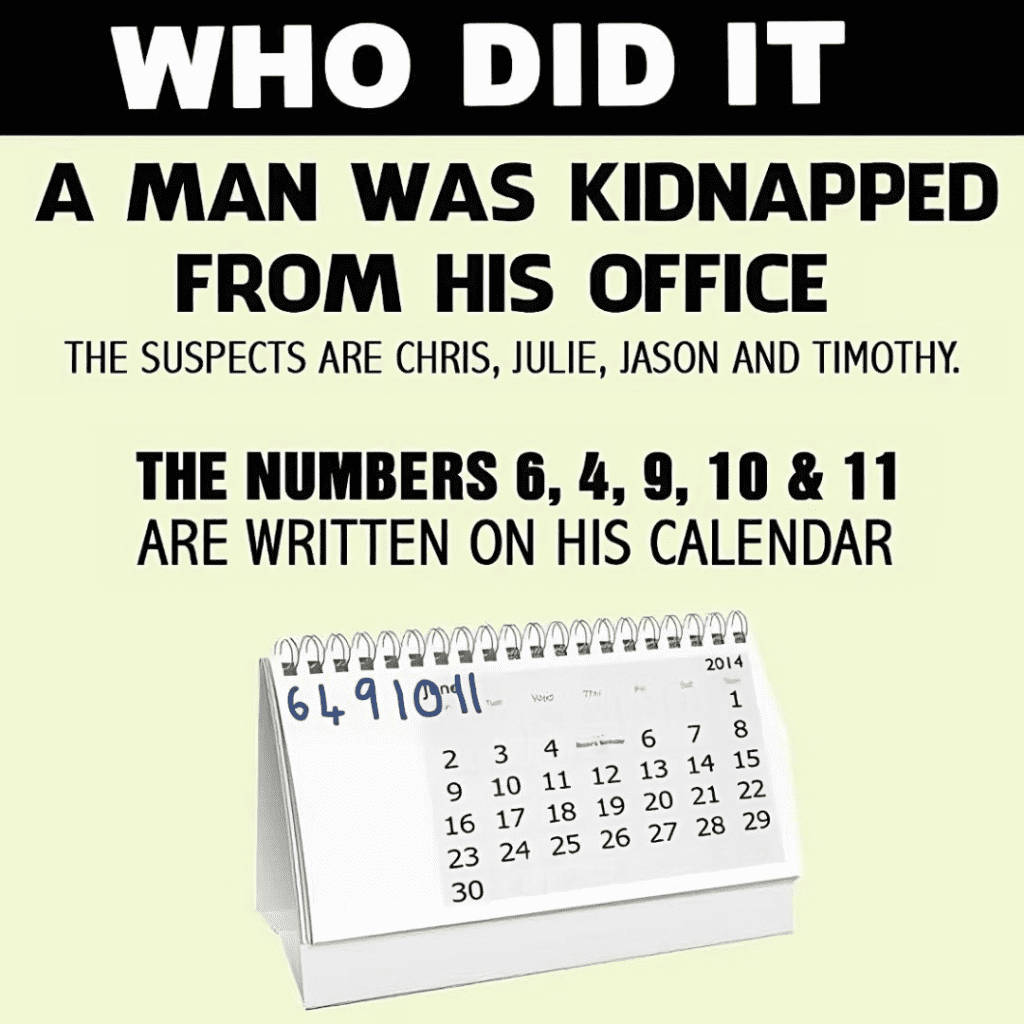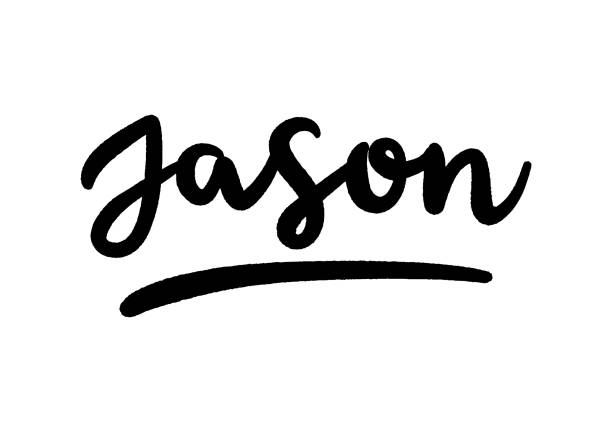Puzzles that test our critical thinking are not just fun—they’re a powerful way to sharpen logic and reasoning. Today, we have a fascinating challenge: “Who Did It?” The story involves a man kidnapped from his office, leaving behind a crucial clue: five numbers written on his calendar. You have four suspects to choose from: Chris, Julie, Jason, and Timothy. The numbers—6, 4, 9, 10, and 11—are the only clues. But how are they connected to the suspects? Let’s dive into the mystery and find out!

Common Mistakes When Solving Puzzles Like This
Before we jump into the solution, let’s explore some common mistakes people make when tackling puzzles of this nature:
1. Overcomplicating the Numbers:
A typical mistake is to assume the numbers represent a complex code, leading solvers to look for cryptic patterns or advanced encryptions.
2. Ignoring the Context:
It’s easy to overlook the fact that the numbers are written on a calendar. This is a major hint that directs solvers to think in terms of months, rather than specific dates or times.
3. Failing to See the Pattern:
The solution lies in recognizing a simple pattern connected to the months of the year. Missing this connection can make the puzzle seem harder than it really is.
Now that we know what pitfalls to avoid, let’s break down the steps to solve this puzzle and reveal the kidnapper’s identity!
Step-by-Step Solution: Decoding the Calendar Numbers
The numbers on the calendar—6, 4, 9, 10, and 11—hold the key to solving this puzzle. Here’s how to decipher them step by step.
Step 1: Interpret the Numbers as Months
The first step is to realize that the numbers likely represent months of the year. Each number corresponds to a specific month:
- 6 stands for June
- 4 stands for April
- 9 stands for September
- 10 stands for October
- 11 stands for November
By identifying these numbers as months, we’re moving closer to the solution.
Step 2: Extract the First Letter of Each Month
Next, we take the first letter of each month identified in Step 1:
- 6 (June) gives us ‘J’
- 4 (April) gives us ‘A’
- 9 (September) gives us ‘S’
- 10 (October) gives us ‘O’
- 11 (November) gives us ‘N’
Step 3: Form the Name from the Letters
Now, arrange these letters in the order of the numbers: J, A, S, O, N.
What does this spell? It spells Jason, which is the name of one of the suspects. Therefore, the kidnapper is Jason!
Why Details Matter in This Puzzle
This puzzle is a classic example of how paying attention to small details can lead to an unexpected solution. Here’s why the details are crucial:
1. Dual Meaning of the Numbers:
The numbers don’t just represent months—they also serve as a code that forms a name. It’s a simple yet clever way of hiding information in plain sight.

2. Using the Calendar Context:
The calendar setting is more than just a background detail—it’s a vital clue that points solvers toward interpreting the numbers as months. Ignoring this detail can easily lead to confusion.
3. Elegant Simplicity:
The puzzle appears complex at first, but it has a straightforward solution once you realize the pattern. It’s a reminder that not all challenging problems require complex answers—sometimes, you just need a shift in perspective.
How to Improve Your Puzzle-Solving Skills
This puzzle teaches us some valuable problem-solving lessons that you can apply to other puzzles as well:
1. Look Beyond the Obvious:
When faced with a puzzle, try to think of different ways to interpret the information given. Don’t settle for the most apparent answer—explore alternative possibilities.
2. Pay Attention to Context:
The setting of a puzzle can offer significant clues. In this case, the presence of a calendar hinted at the importance of months, guiding us to the correct solution.
3. Break It Down Step by Step:
Complex puzzles can often be simplified by breaking them into smaller parts. Analyze each element, like we did with the numbers, to find a clear path to the solution.
Conclusion: Did You Solve the Puzzle?
So, were you able to figure it out on your own, or did you need a little help? If you successfully solved it, you’re on your way to becoming a master puzzle-solver! If you struggled at first, don’t worry—this puzzle is designed to be tricky, and the solution requires a different way of thinking.
Puzzles like this one aren’t just entertaining; they help improve your critical thinking and attention to detail. They force you to look beyond the obvious and explore every angle. If you enjoyed this puzzle, keep challenging yourself with more logic-based puzzles to keep your mind sharp. The more you practice, the better you’ll get at spotting hidden clues and solving even the toughest mysteries.
Stay curious, keep solving, and remember: sometimes, the simplest answer is hidden in plain sight!


